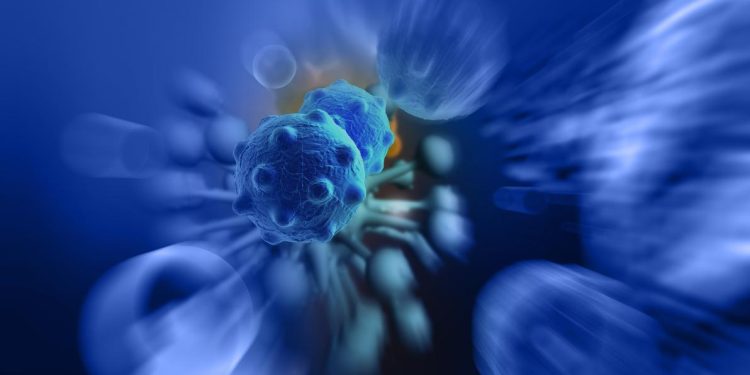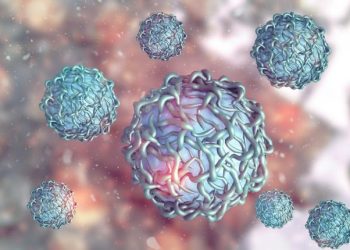Follicular lymphoma is a type of low-grade (slow growing) non-Hodgkin lymphoma. It develops in white blood cells called lymphocytes, which are part of the body’s immune system and help fight infections.
Follicular lymphoma can grow slowly and you may not need treatment right away. Your healthcare team will monitor you closely with regular checkups. They’ll start treatment when your symptoms show up or the lymphoma grows faster than expected.
Swollen Lymph Nodes
Follicular lymphoma is one of the types of low-grade non-Hodgkin lymphoma (NHL). It happens when white blood cells called lymphocytes grow out of control in your body’s lymphatic system. This system has tubes that branch through all parts of the body. Lymphocytes are part of the immune system and help your body fight infection.
Swollen lymph nodes are usually the first sign of follicular lymphoma. They feel like hard lumps under the skin and often appear in the neck, armpit, or groin areas. Sometimes, you can have swollen lymph nodes for years before your doctor finds them and diagnoses you with follicular lymphoma.
Lymph nodes that are swollen due to infection usually go down and disappear within a few weeks once the body has fought off the infection. But swollen lymph nodes that stay enlarged for more than a few weeks might be a sign of a more serious infection or disease, such as cancer.
Your doctor will do a physical exam and talk with you about your symptoms. They may also order medical tests and imaging tests. These include a lymph node biopsy, a CT scan, a PET-CT scan, and blood tests.
A lymph node biopsy is when your doctor removes part or all of a swollen lymph node and checks it under a microscope to see if it’s cancerous. They might also do a bone marrow test to see if the lymphoma has spread to your bone marrow.
Most follicular lymphoma is slow-growing, or low-grade. But this type of lymphoma can grow fast, so you might need treatment right away if you have other signs of the disease, such as fever, chills, night sweats, weight loss, or a drop in your blood counts.
Fatigue
Follicular lymphoma can be a slow-growing type of non-Hodgkin lymphoma (NHL). It affects white blood cells, called lymphocytes. It is usually found in the lymphatic system, a network of tubular channels that branch throughout the body. The lymphatic system drains a thin watery fluid, called lymph, from different parts of the body into the bloodstream. This fluid contains proteins, fats and white blood cells that help fight infection.
When the lymphocytes grow out of control, they can cause cancerous cells to form. Some of these cancerous cells develop into enlarged lymph nodes, which doctors call follicular lymphoma. The swollen lymph nodes may feel like lumps in your neck, armpit or groin. Sometimes they’re painless, and you might not be able to feel them at all. The swollen lymph nodes can also lead to other symptoms of follicular lymphoma, including fever, night sweats, weight loss and changes in your blood counts.
Researchers don’t know what causes follicular lymphoma. But they do know that certain changes in a person’s chromosomes can make them more likely to get it. They also know that follicular lymphoma grows slowly and can be treated with medication.
In some cases, follicular lymphoma doesn’t cause any symptoms at all and doesn’t need treatment right away. This is called watchful waiting and it’s done with regular visits to your healthcare provider, blood tests and imaging scans.
When you’re tired, it can be hard to think clearly and manage your emotions. Try to take good care of yourself by getting enough rest, eating a healthy diet and exercising regularly. It’s also important to talk about your feelings with a friend or counselor.
Fever
Fever is a common symptom of follicular lymphoma. It may be caused by cancer cells or by inflammation in the lymph nodes or other organs. Fever can also be a side effect of certain medicines or treatments.
Some people are able to manage their follicular lymphoma without treatment and can live for years without symptoms. Others need treatment to prevent the cancer from growing and spreading.
Your healthcare team will check you for symptoms of follicular lymphoma. They’ll check your blood for signs of cancer, such as high levels of an enzyme called lactate dehydrogenase (LDH). Your doctor will also palpate any hardened lumps in your neck, armpit, and groin. They’ll also check if your spleen is enlarged. They’ll take a sample of your bone marrow for tests to see how healthy it is.
The first sign of follicular lymphoma is usually one or more swollen lymph nodes, which feel like hard lumps under the skin. They might be found in your neck, armpits, groin, or behind your knees. Lymph nodes are part of the body’s immune system and help fight infections. They aren’t normally painful, and swollen lymph nodes can have many causes that don’t involve cancer.
Swollen lymph nodes are often the only symptom of follicular lymphoma, but they can be joined by other symptoms, such as weight loss, drenching sweats, and fever. The combination of these symptoms is known as B symptoms and can make it difficult to distinguish follicular lymphoma from other problems that might cause these symptoms.
Follicular lymphoma develops slowly and doesn’t spread quickly. So if it’s only in one area, you might not need treatment right away. Your healthcare team will monitor you with regular check ups and might treat you with chemotherapy if they think your lymphoma is progressing or causing symptoms.
Weight Loss
Follicular lymphoma is a type of non-Hodgkin lymphoma, which is cancer that starts in the lymphatic system. The lymphatic system is a network of tubular channels (lymph vessels) that drain a thin, watery fluid called lymph from different areas of the body into the bloodstream. Lymph contains proteins, fats, and certain white blood cells that help fight infections.
Doctors don’t know what causes follicular lymphoma or other non-Hodgkin lymphomas. These cancers tend to grow slowly and often don’t cause symptoms in their early stages. The first symptom is usually one or more swollen lymph nodes that feel like hard lumps under the skin. The swollen nodes may come and go for months or years before you get a diagnosis.
The swollen nodes are usually found in the armpit, neck, and groin. They can also appear in the chest and abdomen. There is a subtype of follicular lymphoma that can start in the gastrointestinal tract, and it tends to have a better outlook than follicular lymphoma that starts in other parts of the body.
To make a diagnosis, your doctor will do a physical exam and ask you about any symptoms you’ve been having. Your doctor will also order a blood test to check your red blood cell count, white blood cell count, platelet count, and the levels of an enzyme called lactate dehydrogenase (LDH).
The initial treatment for follicular lymphoma is chemotherapy. A combination of drugs is used and is referred to as a regimen. These drugs are usually given intravenously, and they are given in cycles that last for four weeks. During each cycle, you receive the drug infusions two days in a row and then wait a week before you receive another dose.
Pain
Follicular lymphoma is a type of non-Hodgkin’s lymphoma. It grows slowly and doesn’t cause many symptoms right away. But it can grow and spread more quickly in later stages.
The first symptom is often swollen lymph nodes. These might look like lumps under the skin, especially in your neck, armpit, or groin. They might not hurt, but they can press against other organs, causing pain. The other main symptom is fatigue. This is an ongoing feeling of tiredness that doesn’t go away, and it may be severe enough to stop you from going about your daily life. You might also have fever and drenching night sweats.
These are all symptoms of follicular lymphoma, but not everyone gets them. This is because follicular lymphoma can be different for each person. There are many risk factors that might make you more likely to develop it, but some people have these risk factors and never get follicular lymphoma.
Your healthcare provider can diagnose follicular lymphoma by taking a sample of the affected lymph nodes and looking at them under a microscope. They might also order a blood test to check for certain proteins and genetic changes.
They might also use other tests to help them see how advanced the cancer is, such as a computed tomography (CT) scan or positron emission tomography (PET) scan. These tests show how fast or slow the cancer cells are growing.
Follicular lymphoma typically affects your B lymphocytes, which are part of your immune system. These help fight infections and diseases such as cancer. But sometimes the faulty B lymphocytes develop into cancer cells, which grow and spread in your body. These cancer cells can be found throughout the body, but they usually start in your lymph nodes.









